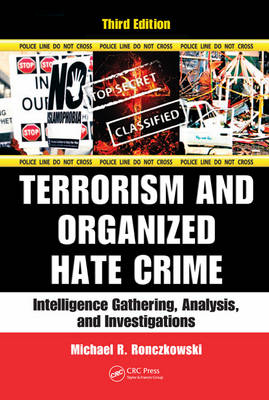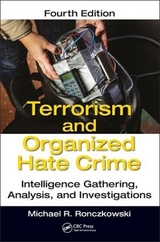
Terrorism and Organized Hate Crime
Crc Press Inc (Verlag)
978-1-4398-6759-4 (ISBN)
- Titel erscheint in neuer Auflage
- Artikel merken
Using techniques applicable to the private and the public sector, the book combines academic, research, and practitioner perspectives to establish a protocol for effectively gathering, analyzing, investigating, and disseminating criminal intelligence. The book demonstrates how to recognize the indicators of an impending act of terrorism or mass violence, how to deter an attack, and how to transform information into intelligence to meet community demands for safety and security.
New chapters in this third edition focus on source development and their use in investigations, the role of fusion centers, terrorism financing, the handling of classified materials, and the National Suspicious Activity Reporting (SAR) Initiative. The book also discusses pre-incident indicators, the radicalization process, and behavioral traits associated with terrorism.
A one-stop resource for the homeland security, intelligence analyst, and investigative professional, this volume arms those tasked with protecting the public with a solid blueprint for combating and investigating crimes associated with terrorism and hate.
Major (honorably retired as of April 2010) Michael Ronczkowski served the citizens of Miami-Dade County Florida and Miami-Dade Police Department for nearly 27 years. He rose through all the Civil Service Ranks serving as a Corporal, Sergeant, Lieutenant, and Captain before his appointment to Major in the spring of 2006. His assignments consisted of 19 years of investigations to include; burglary, auto theft, assault, robbery, fugitives and homeland security which included the Joint Terrorism Task Force. Major Ronczkowski retired after serving four years as the Department’s Homeland Security Bureau Commander and Director of the Miami-Dade Fusion Center a DHS recognized center that he initiated. He commanded and managed 80 multi-discipline personnel on homeland security and terrorism-related investigations at the Fusion Center which served South Florida. Major Ronczkowski also served as the Chair of the County’s Terrorism Advisory Committee (TAC), member of the Southeast Regional Domestic Security Task Force (SERDSTF), Urban Area Security Initiative (UASI) Grant Program and Urban Area Work Group (UAWG) board member for Miami and Ft. Lauderdale, and Major Cities Chiefs Association Intelligence Commanders Group advisor. He also maintained high level national security clearances and credentials with the Miami Office of the FBI JTTF. Major Ronczkowski has testified before both the U.S. Senate and Congress on matters related to Islamic Extremism and Emergency Response. Major Ronczkowski holds a Bachelor’s degree in Criminal Justice and a Masters degree in Public Administration from Florida Atlantic University as well as being a graduate of the FBI’s National Academy, Session 217. He is the author of several publications to include two text books published with CRC Press titled Terrorism and Organized Hate Crime and co-author of the article Tactical / Investigative Analysis of Targeted Crimes, published by the National Institute of Justice in the Advanced Crime Mapping Topics book sponsored by the Crime Mapping and Analysis Program as well as three contributing articles for various encyclopedias. Major Ronczkowski is also an established instructor on matters related to homeland security, intelligence, analysis, and a certified GIS instructor with ESRI. He served eight years as an adjunct professor at Florida Atlantic University teaching terrorism and has been an instructor for the Alpha Group Center for Crime and Intelligence Analysis for nearly 10 years.
A need for understanding and analysis
The mission
Intelligence analysis units
Defining analytical positions and roles
Intelligence disciplines
What is homeland security and terrorism analysis?
Understanding what needs to be analyzed
Keys to analysis
Deterrence, prevention, arrest, and target hardening
Deterrence
Prevention
Arrest
Target hardening
Understanding and defining terrorism
Defining terrorism
Defining terrorist activity
Forms of terrorism
Political terrorism
Ecological terrorism
Agricultural terrorism
Narco-terrorism
Biological terrorism
Cyberterrorism
History and roots of modern terrorism
The evolution of domestic terrorism
Domestic terrorism
Organized hate groups and crimes
Role of organized hate groups in domestic terrorism
What is a terrorist?
Terrorist versus street criminal
Understanding the religious connection
Islamic extremism
Islamic sects
Terrorism: Structure and management
Homeland security and analysis
Definition of homeland security
Homeland Security Advisory System
The updated Homeland Security Advisory System
National Threat Advisory System
Homeland security and analysis
The Uniting and Strengthening America by Providing Appropriate Tools
Required to Intercept and Obstruct Terrorism Act
Importance of finances in terrorist activities
Hawala system
Charitable contributions—zakat
Dealing with terrorism
Law enforcement concerns
Coordination, training, and awareness
Behavioral traits and suspicious activity
National information sharing and suspicious activity reporting
Why suspicious activity reporting, and the role of local law enforcement
Suspicious activity reporting and the national landscape
Suspicious activity reporting behavioral indicators
Actions arousing suspicion
Possession arousing suspicion
Retrieving the suspicious activity report for analysis
Terrorism information needs
Radicalization and behaviors
Early indicators of terrorism
Would-be warriors
Relationships of people, places, and things
Data and information quality
Information life cycle
Information quality
Gathering information, the key to the process
Intelligence gathering
Role of the first responder
Crimes and incidents that may yield information or links
Stolen identities
False identification
Gathering limitations and restrictions
Gathering information from tips
Intelligence gathering and information interpretation
Evaluating the information used
Enhancing investigations: Going beyond the traditional
Middle Eastern criminal enterprises
Financing terrorism through various forms of criminal activity
Role of the financial investigator in the intelligence process
Role of fusion centers in the intelligence process
Intelligence-led policing
Fusion centers
Handling of classified materials
Security and nondisclosure
Source development and use in investigations (human intelligence)
Source development and handling procedures
Source management
Open source reporting
Confidential source management and reporting
Working the puzzle one piece at a time: Learning to anticipate behavior
Data set challenges
Names and addresses
Data tools
Identifying what is needed
Forms of analysis that can be used to identify the missing piece
Use of calendars and significant dates in analysis
When is 9/11 not 9/11?
Dates of terrorism significance
Learning from past behavior
Looking for skill, knowledge, resource, access(ibility), motive
Recruiting opportunities
Prisons—Recruitment and communication
Ability to communicate from within
Gangs—Today’s street terrorists
Mara Salvatrucha 13 and Sureño 13
Music—Another means to recruit
Enhanced analysis: Transforming information into intelligence
Analyzing: Transforming information into intelligence
Analytical and investigative variables
Websites and other resources
Macro-micro-macro continuum
Link analysis charts
Association and directional matrices
Event flowcharts
Heuer’s analysis of competing hypotheses (ACH)
Assessing the threat
Vulnerability assessment
Spatial referencing and its use in homeland security analysis
Range of geographic information system uses
Preparation and planning
Geographic information system linking
Additional benefits of a geographic information system
Dissemination of intelligence
Commonly used analytical reports
The threat: The future is here today—Learning from the past
Transportation targeted
Transportation and terrorism
The Irish Republican Army campaign against transportation
Planes, trains, and automobiles—But there are more
United States: Terrorism and transportation
Symbolic government targets
Notable terrorist cases and attacks with a transportation nexus other than 9/11
Aviation (Figure 9.1)
Maritime
Buses and trains/railways
Trucks, cars, vans, taxis, limos, and rescue vehicles
Bicycles
Summary of recent transportation targets
Use of suicide bombers
Who are the bombers and their groups?
What can you look for?
Homegrown terror—Learning from others
Expanded details
Cases for groups found in the United States and abroad
Other notable cases
What the future may hold
Foreign-based terrorist influence
Groups, movements, and ideologies with a presence in the United States
Hezbollah
Al-Gama’a al-Islamiyya
Hamas (Islamic Resistance Movement)
The Muslim Brotherhood Movement (Hizb al-lkhwan al-Muslimun)
Wahhabism
Means of support
Cyberterrorism
Defining cyberterrorism
Spectrum of cyber conflict
Using Internet Protocol addresses and e-mails in analysis
Some Internet problems that might come up during analysis
Finding information in an e-mail
E-mail addresses
What is an Internet Protocol address?
No message, no extended header, no Internet Protocol address
Tracing an e-mail address to an owner
Does the target have a web page?
How does one trace a web address?
Bioterrorism and weapons of mass destruction
The past, present, and future
Conclusion
Expanding horizons through media outlets
Muslim/Arab Internet news sites and resources
Appendix A: Domestic-based terrorist organizations
Appendix B: "Patriot" groups in the United States
Appendix C: Symbols of hate
Appendix D: Foreign-based terrorist organizations
Appendix E: Explosive materials
Appendix F: Homeland security state contact list
Appendix G: Publication references
Appendix H: Government legislative references
Appendix I: Glossary of terminology
Appendix J: Department of Homeland Security recognized fusion centers
Index
| Erscheint lt. Verlag | 28.10.2011 |
|---|---|
| Zusatzinfo | 1 in text box; 2 Tables, black and white; 84 Illustrations, black and white |
| Verlagsort | Bosa Roca |
| Sprache | englisch |
| Maße | 174 x 246 mm |
| Gewicht | 953 g |
| Themenwelt | Informatik ► Netzwerke ► Sicherheit / Firewall |
| Recht / Steuern ► EU / Internationales Recht | |
| Recht / Steuern ► Strafrecht ► Kriminologie | |
| Sozialwissenschaften ► Politik / Verwaltung | |
| ISBN-10 | 1-4398-6759-3 / 1439867593 |
| ISBN-13 | 978-1-4398-6759-4 / 9781439867594 |
| Zustand | Neuware |
| Haben Sie eine Frage zum Produkt? |
aus dem Bereich



